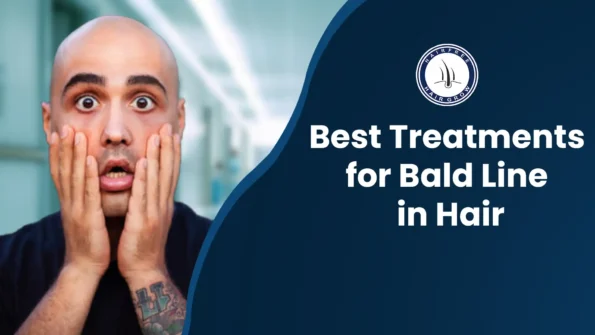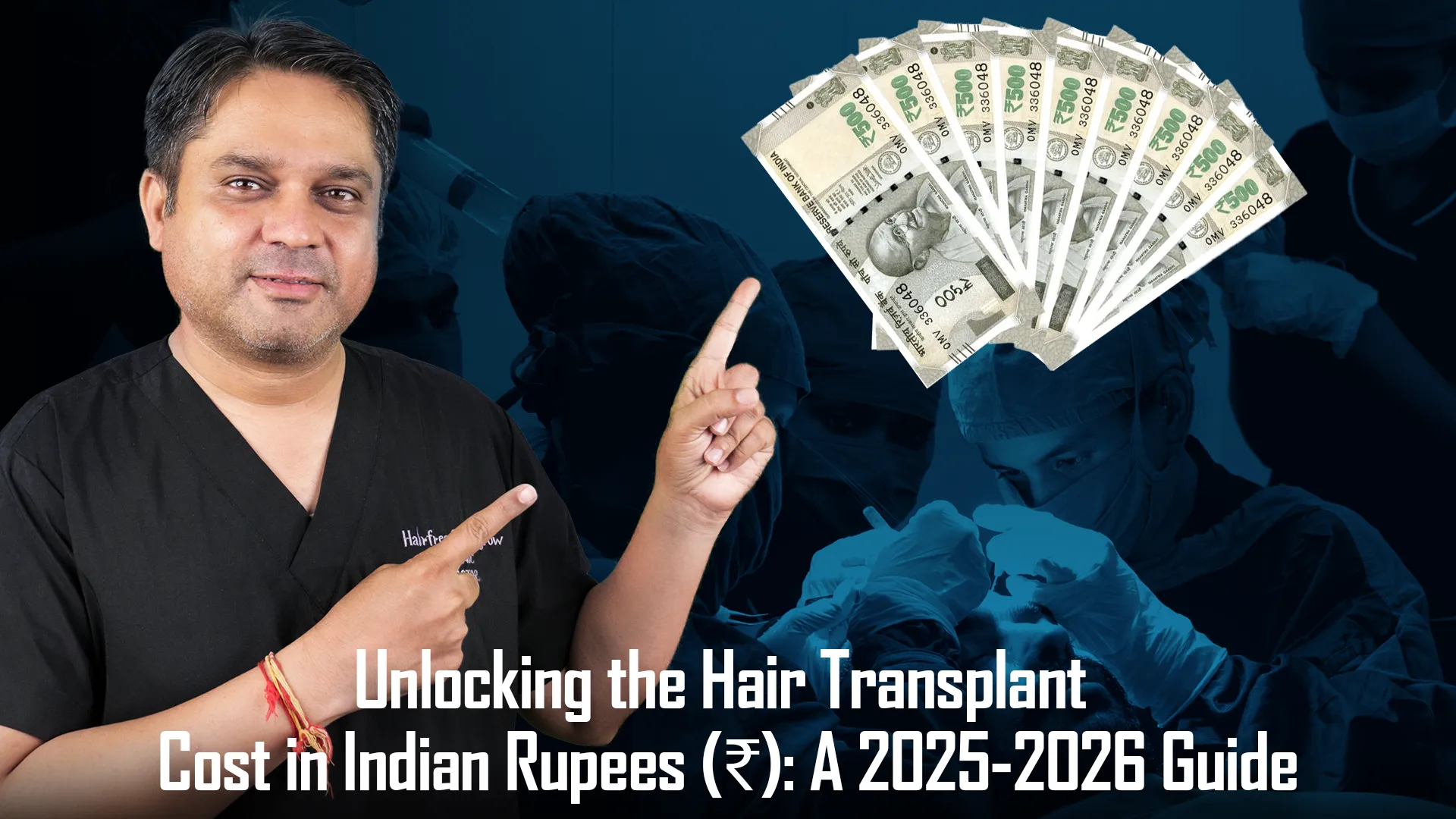Discovering a bald line in your hair can feel like a punch to your confidence. Whether it’s a widening part, patchy spots, or a thinning streak, that visible scalp can make you hyper-aware of your appearance. You’re not alone—millions notice this issue and search for solutions to restore their hair and self-esteem. The good news? There are treatments for a bald line in hair, ranging from quick fixes to the gold standard: hair transplants. In this guide, we’ll explore every option to help you find the best path forward.
What Is a Bald Line in Hair?
A bald line in hair refers to a visible strip of scalp where hair has thinned or disappeared, often along the parting line or crown. It might look like a wider-than-usual part, patchy areas, or an uneven hairline. This issue affects both men and women, though it’s more noticeable in those with longer hair or specific hairstyles.
Who Experiences It?
- Men: Often tied to male pattern baldness, starting at the crown or temples.
- Women: May notice it due to hormonal changes, stress, or tight hairstyles.
- Causes: Genetics, aging, stress, or underlying health issues can trigger it.
If you’re seeing early hair loss or hair thinning, a bald line could be the first sign. Let’s dig into why it happens.
Common Causes of a Bald Line in Hair
Understanding the root cause of your bald line is key to choosing the right treatment. Here are the most common culprits:
1. Genetics and Pattern Baldness
Male and female pattern baldness (androgenetic alopecia) is the leading cause. In men, it often starts at the crown, creating a bald line. Women may notice a wider part due to diffuse thinning.
2. Stress and Hormonal Changes
Stress can push hair into a shedding phase (telogen effluvium), while hormonal shifts—like pregnancy, menopause, or PCOS—can thin hair along the part line.
3. Poor Scalp Health or Hairstyles
Tight ponytails, braids, or extensions can cause traction alopecia, where hair is pulled out, leaving a bald line. Scalp conditions like dandruff or psoriasis may also contribute.
4. Nutritional Deficiencies
Lack of iron, zinc, or biotin can weaken hair follicles, leading to thinning and bald lines.
Temporary Solutions for a Bald Line in Hair
If you’re looking for immediate or affordable ways to tackle a bald line, these options can help, though results are often short-term.
Topical Products
- Minoxidil: A clinically proven over-the-counter treatment (2% or 5% strength). Apply it daily to stimulate hair follicles. Results may take 3–6 months, and consistency is key.
- Hair Growth Serums: Contain peptides or plant extracts to nourish the scalp. Brands like The Ordinary or Vegamour are popular but vary in effectiveness.
Natural Remedies
- Onion Juice: Studies suggest it may promote regrowth due to sulfur content. Apply to the scalp, leave for 15 minutes, and rinse.
- Rosemary Oil: Known to improve circulation when massaged into the scalp. Mix with a carrier oil and use weekly.
- Scalp Massages: Boost blood flow to follicles. Spend 5–10 minutes daily massaging your scalp.
Cosmetic Quick Fixes
- Hair Fibers: Products like Toppik sprinkle keratin fibers to mimic hair, instantly masking bald lines.
- Scalp Concealers: Tinted powders or sprays (e.g., DermMatch) cover exposed scalp.
- Strategic Hairstyling: Side parts, zig-zag parts, or volumizing products can hide thinning areas.
Note: These solutions are temporary and may not address the underlying cause. For faster or lasting results, consider medical treatments.
Medical Treatments for a Bald Line in Hair
When temporary fixes aren’t enough, medical treatments offer stronger solutions. Here’s what’s available:
1. PRP Therapy (Platelet-Rich Plasma)
PRP therapy involves drawing your blood, concentrating the platelets, and injecting them into the scalp. Platelets release growth factors to stimulate hair follicles.
- How It Works: 3–6 sessions, spaced 4–6 weeks apart.
- Results: Thicker hair in 3–6 months, best for early thinning.
- Pros: Non-surgical, minimal downtime.
- Cons: May require maintenance sessions.
2. Low-Level Laser Therapy (LLLT)
LLLT uses red light to energize hair follicles, improving growth.
- Devices: At-home caps (e.g., Capillus) or in-clinic sessions.
- Effectiveness: Best for mild thinning, with results in 4–6 months.
- Tip: Consistency is crucial for success.
3. Prescription Treatments
- Finasteride: A daily pill for men that blocks DHT, a hormone linked to hair loss. Not for women due to side effects.
- Spironolactone: Often prescribed for women with hormonal hair loss. It reduces androgen levels to slow thinning.
These treatments work best for early-stage bald lines but may not fully restore severe hair loss.
Hair Transplant: The Most Effective Long-Term Solution
For a permanent fix, nothing beats a hair transplant. Here’s why it’s the gold standard for treating a bald line in hair.
Why It’s the Best
Hair transplants move healthy follicles from a donor area (usually the back of the head) to the bald line, creating natural, lasting results. Once transplanted, the hair grows for life.
Types of Hair Transplant
- FUE (Follicular Unit Extraction): Individual follicles are extracted and implanted. Minimal scarring, ideal for small bald lines.
- DHT (Direct Hair Transplant): Follicles are implanted immediately after extraction for higher survival rates.
- I-FUE: An advanced FUE with precision tools for better results.
- BIO-FUE: Combines FUE with growth factors to enhance healing.
Who Is an Ideal Candidate?
- Extent of Bald Line: Best for defined thinning areas, not diffuse loss.
- Donor Area: You need enough healthy hair at the back or sides.
- Health: Good overall health ensures better recovery.
What to Expect
- Procedure: Takes 4–8 hours under local anesthesia. You’re awake but comfortable.
- Recovery: Mild swelling or redness for 3–7 days. Most return to work in a week.
- Results Timeline: New hair grows in 3–4 months, with full results by 12–18 months.
Success Rate and Longevity
Studies show 85–95% of transplanted follicles survive, delivering permanent results. Patient satisfaction is high, especially with skilled surgeons.
Choosing the Right Clinic or Specialist
A great clinic can make or break your results. Here’s what to prioritize:
Best Hair Transplant Clinic
When it comes to treating a bald line in hair with precision and lasting results, Hairfree & Hairgrow Clinic stands out as one of India’s most trusted names in hair restoration.
Why Hairfree & Hairgrow Clinic?
- Over 19+ years of experience.
- 12 branches across India including Pune, Delhi, Ahmedabad, Hyderabad & more.
- Team of experienced doctors: Dr. Chintan Bhavsar, Dr. Kiran Chotaliya & Dr. Shreedevi Lakhe.
- Personalized hair transplant plans using latest technologies like I-FUE and BIO-FUE.
- Thousands of successful results and happy patients.
Costs of Treating a Bald Line in Hair in India
Treatment | Cost Range (INR) | Notes |
Minoxidil/Serums | ₹300–₹2,500/month | Ongoing cost; affordable but needs daily use. |
PRP Therapy | ₹5,000–₹15,000/session | 3–6 sessions needed; total ₹15,000–₹90,000. Maintenance adds cost. |
LLLT Devices | ₹40,000–₹1,50,000 (one-time) | Clinic sessions ₹20,000–₹60,000. Home devices save money long-term. |
Hair Transplant (FUE) | ₹30,000–₹1,50,000 | Depends on grafts (500–1,500). Permanent solution; EMI often available. |
Prevention Tips to Avoid Worsening the Bald Line
Slow down hair loss with these habits:
- Scalp Care: Use gentle, sulfate-free shampoos. Avoid overwashing.
- Hairstyles: Skip tight buns or braids to prevent traction alopecia.
- Nutrition: Eat foods rich in iron, zinc, and protein (e.g., spinach, eggs, nuts).
- Stress Management: Try yoga, meditation, or therapy to reduce cortisol levels.
Final Thoughts: Which Treatment Is Best for You?
The right treatment depends on your bald line’s severity, budget, and goals:
- Mild Thinning: Start with minoxidil, PRP, or natural remedies.
- Moderate Loss: Consider PRP, LLLT, or prescriptions for better results.
- Visible Bald Line: A hair transplant offers the most natural, permanent fix.
For those seeking a one-time solution, a hair transplant stands out. It’s an investment in your confidence with results that last a lifetime.
Ready to fix your bald line? Book a consultation with a trusted hair specialist to create your personalized treatment plan.
Ready to fix your bald line? Book a consultation with a trusted hair specialist to create your personalized treatment plan.
FAQs About Bald Line in Hair
1. Is a bald line a sign of permanent hair loss?
Not always. Temporary causes like stress or deficiencies can be reversed, but genetic baldness may require ongoing treatment.
2. Can women also get bald lines in hair?
Yes, women often notice bald lines due to hormonal changes, PCOS, or traction alopecia.
3. How long before I see results from treatment?
- Minoxidil: 3–6 months
- PRP/LLLT: 4–6 months
- Hair Transplant: 12–18 months for full results
4. Can a bald line in hair grow back naturally?
If caused by temporary factors (stress, diet), it may regrow with lifestyle changes. Genetic bald lines often need medical intervention.
5. How effective is a hair transplant for bald lines?
Extremely effective, with 85–95% graft survival and natural, permanent results when done by a skilled surgeon.
Written By
MBBS, MD
Dr. Pratibha Pradhan is a renowned hair restoration expert specializing in the best treatments for a bald line in hair. With extensive experience in advanced therapies and personalized care, she helps patients restore hair density and confidence through proven, effective medical and surgical solutions.
Disclaimer
We’ve made all possible efforts to ensure that the information provided here is accurate, up-to-date and complete, however, it should not be treated as a substitute for professional medical advice, diagnosis or treatment. See Detailed Disclaimers Here.




